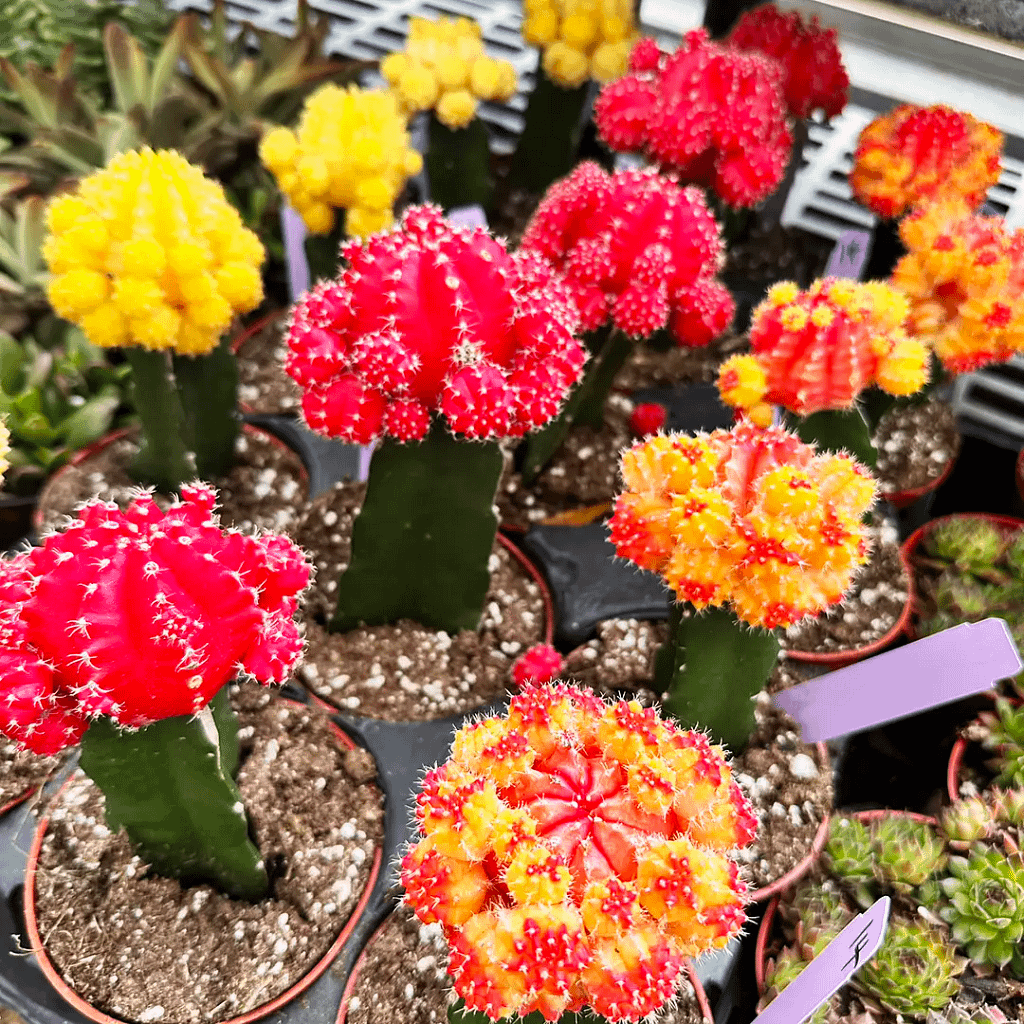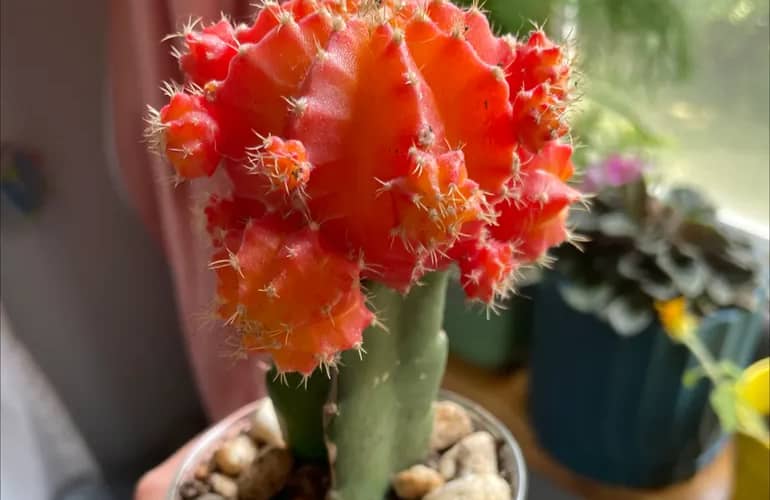Learn all about the Moon Cactus, from its unique characteristics to the best practices for care and cultivation. Discover how to keep this vibrant, colorful plant healthy and thriving in your home.
Introduction
The Moon Cactus (Gymnocalycium mihanovichii), known for its vibrant and eye-catching colors, is a popular choice among houseplant enthusiasts. This unique cactus is actually a grafted plant, combining two different species to create a visually striking and easy-to-care-for succulent. This guide covers everything you need to know about growing and maintaining a Moon Cactus, ensuring it thrives in your home.
What is a Moon Cactus?
Characteristics
It is distinctive for its colorful top, which can be red, pink, yellow, or orange, sitting atop a green base cactus. The vibrant top portion is a Gymnocalycium mihanovichii, which lacks chlorophyll and cannot photosynthesize. Therefore, it is grafted onto a rootstock cactus, typically a Hylocereus species, which provides the necessary nutrients.
Origin
Native to South America, specifically Paraguay and Argentina, it was first discovered in the early 1900s. The grafting process that creates the Moon Cactus as we know it today was developed to enhance its aesthetic appeal and growth potential.
Grafting Process
The grafting involves attaching the colorful Gymnocalycium mihanovichii to a hardy Hylocereus rootstock. This process allows the top cactus to thrive by receiving nutrients from the rootstock.
Benefits of Growing
Aesthetic Appeal
The Moon Cactus is a striking addition to any indoor garden with its bright, cheerful colors. Its compact size makes it perfect for small spaces, windowsills, and desk decorations.
Low Maintenance
Moon Cacti are relatively low maintenance, making them ideal for busy individuals or those new to plant care. They need very little water and can flourish in a variety of indoor settings.
Choosing the Right Moon Cactus
Varieties and Colors
Moon Cacti come in a range of colors, each offering unique visual appeal. Common colors include:
- Red
- Pink
- Yellow
- Orange
When selecting a Moon Cactus, choose one with vibrant colors and a healthy appearance.

Ideal Growing Conditions
Light Requirements
Moon Cacti prefer bright, indirect light. Direct sunlight can be too intense and may cause the colors to fade or the plant to scorch. An ideal location is a window facing north or east.
Temperature
These cacti thrive in temperatures between 65°F to 80°F (18°C to 27°C). They can tolerate slightly cooler temperatures but should be kept away from cold drafts and sudden temperature changes.
Humidity
Moon Cacti prefer low to moderate humidity. High humidity levels can lead to rot and other issues. Ensure proper ventilation in more humid environments.
Soil and Potting
Best Soil Types
Use a well-draining cactus or succulent potting mix. Incorporating sand or perlite can enhance drainage and prevent waterlogging.
Pot Selection
Select a pot with drainage holes to avoid water buildup.Terra cotta pots are a good option as they allow excess moisture to evaporate.
Repotting Tips
Repot your Moon Cactus every 2-3 years or when the rootstock outgrows the current pot. Gently remove the cactus, shake off excess soil, and place it in a new pot with fresh soil.
Watering Your Moon Cactus
Frequency
Water your Moon Cactus sparingly. Let the soil dry out completely between waterings. Overwatering is a common mistake and can cause root rot.
Methods
Use a watering can with a narrow spout to direct water to the base of the cactus, avoiding the top graft. Ensure the pot drains well after watering.
Common Mistakes
- Overwatering: Leads to root rot and fungal issues.
- Underwatering: Causes the cactus to shrivel and weaken.
- Watering the top: Can lead to rot in the grafted portion.
Fertilizing Your Moon Cactus
When to Fertilize
Fertilize your Moon Cactus during the growing season (spring and summer). Refrain from fertilizing during the dormant period (fall and winter).
How to Fertilize
Apply a balanced, water-soluble cactus fertilizer diluted to half strength every 4-6 weeks during the growing season.
Pruning and Maintenance
Tips for Keeping Your Cactus Healthy
- Remove any dead or yellowing parts.
- Check for pests regularly.
- Periodically rotate the plant to ensure even light exposure.
Common Problems and Solutions
Pests
- Mealybugs: Treat with insecticidal soap or alcohol wipes.
- Spider Mites: Increase humidity and apply miticides if necessary.
Diseases
- Root Rot: Caused by overwatering. Decrease watering frequency and ensure proper drainage.
- Fungal Infections: Use fungicides and improve air circulation.
Troubleshooting Issues
- Fading Colors: Move to a location with more indirect light.
- Shriveling: Increase watering frequency, ensuring the soil dries out between waterings.
Propagating Moon Cactus
Methods
- Offsets: Remove offsets from the base of the rootstock and plant them separately.
- Grafting: Cut a healthy Gymnocalycium mihanovichii and attach it to a new rootstock.
Tips for Successful Propagation
- Use sterilized tools to prevent infection.
- Ensure proper alignment during grafting for successful fusion.
Decorating with Moon Cactus
Creative Display Ideas
- Terrariums: Combine with other succulents for a stunning display.
- Planter Arrangements: Use colorful pots to complement the cactus’s vibrant hues.
- Desk Decor: Place in small pots on your work desk for a touch of nature.
FAQs
How often should I water my Moon Cactus? Water your Moon Cactus every 2-4 weeks, allowing the soil to dry out completely between waterings.
What type of light is best for Moon Cactus? Bright, indirect light is ideal. Avoid direct sunlight, which can cause fading and scorching.
How do I prevent root rot in my Moon Cactus? Ensure proper drainage, use a well-draining soil mix, and water sparingly.
Can I grow a Moon Cactus from seeds? While possible, growing from seeds is challenging. It’s easier to propagate through offsets or grafting.
Why is my Moon Cactus losing color? Color loss can result from inadequate light. Relocate the cactus to a brighter spot with indirect sunlight.
How do I repot a Moon Cactus? Gently remove the cactus from its pot, shake off excess soil, and place it in a new pot with fresh, well-draining soil.

